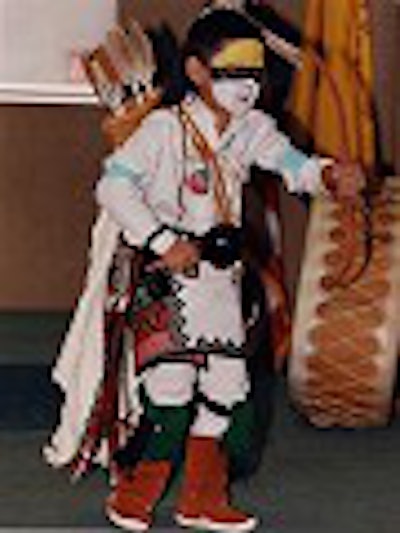
Since 1921, the U.S. Indian Health Service (IHS) has provided comprehensive healthcare to approximately 1.5 million Native Americans and Alaska Natives belonging to more than 557 federally recognized tribes in 35 states.
To administer a full range of care to such widespread populations, the Rockville, MD-based IHS has 12 regional offices nationwide. In all, the IHS program encompasses 36 hospitals, 63 health centers, 44 health stations, five residential treatment centers, and 34 urban Indian health projects, which employ more than 15,000 people from all sectors of medical, social, and environmental health services.
However, clinical staff accounts for less than 5,000 of this 15,000 total, due in part to the service’s high clinical vacancy rate, currently at 12%. To help the program recruit and retain healthcare professionals, the IHS established the Division of Health Professions Support. Consisting of three sections -- the Loan Repayment Program (LRP), IHS Scholarships, and IHS Recruitment -- the stated goals of this new division include assessing IHS professional staffing needs and managing and supporting health profession education programs and activities.
In service and out of debt
The LRP provides for the repayment of undergraduate and graduate health-professions educational loans in exchange for a two-year service obligation. In addition, as loan repayments are considered taxable income, the IHS pays up to 20% of federal taxes on recipients’ loan repayments.
Clinicians who receive these funds are eligible for up to $20,000 per year, totaling a maximum of $40,000 for a two-year contract. "You can also apply for an extension, if the $40,000 doesn’t pay off your debt and you’re still working with the IHS," said Jackie Santiago, the chief of the IHS LRP. "Extensions are for one year at a time. You can keep applying for extensions until your loans are paid off. A lot of people extend three or four times," she said.
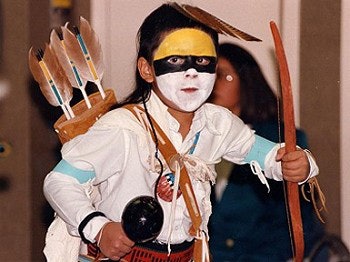 |
| A young boy dancing in full regalia during Heritage Month at the IHS headquarters in Rockville, MD. Photo courtesy of the Indian Health Service/U.S. Department of Health and Human Services. |
The amount awarded per year is determined by the applicant’s debt, Santiago said. "If your debt is over $40,000 -- health and professional educational loans only -- they will get $20,000 a year for two years," she said. "If it’s under that, the award is prorated up to what they owe."
Unfortunately, funds are limited: An applicant’s chances of receiving loan repayment in any given application year is approximately 50%. In 2002, the LRP funded 480 people from a total of 930 applications, Santiago said. Candidates are rated against the IHS’ staffing shortages, which are assessed each year prior to the start of the year’s loan-repayment funding program. Professions rated at a high level of need receive the most funding. This fiscal year, the program has funded a total of 413 awards, with 90 going to physicians, 86 to dentists, and 83 to nurses.
To apply, IHS employees simply fill out application forms from the loan office, copy their licenses to practice, confirm that they are U.S. citizens, and provide IHS-employment verification.
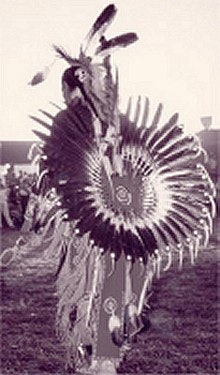 |
| A dancer at a pow-wow in the early days of the IHS (1887-1969). Photo courtesy of the Indian Health Service/U.S. Department of Health and Human Services. |
"We accept applications on a continuous basis," Santiago said. "Usually we start making awards in January and give awards monthly until September 30 or until the funds are depleted -- whichever comes first. The application deadlines are printed in the Federal Register, but they are accepted usually on the Friday of the second week of each month."
Applicants who did not receive funds last year can keep their applications open for the following year. "In October of every year, we send letters to people who’ve applied but weren’t awarded to ask them if they want to keep their application open for the next year. They have to send us something in writing (to keep the application open, but) they don’t have to fill out the application again."
Life in the IHS
Jobs with the IHS span the radiology spectrum. And, in the IHS, a license to practice in one state is as good as a license to practice in every state (except Alaska). Interested clinicians can visit the IHS Web site’s job vacancies database to search for jobs by state or category. As of June 27, 910 jobs were open, with the majority in Arizona (see map below).
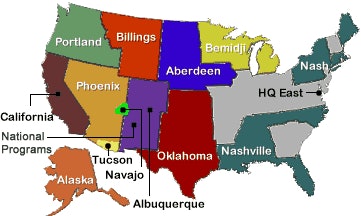
Salaries of IHS positions are calculated on a ranking system, similar to those maintained by most other federal systems. Calculating potential salaries for radiologists with the IHS is difficult due to the program’s bonus system, said Dr. Richard Gwilt, the director of the IHS Medical Imaging Program.
"For example, if they’re board certified, they get a bonus for that. And there are recruitment bonuses," he said. "A ground-level salary (for a radiologist) could be $120,000, approximately. But it depends on the position, their certification status, and bonuses."
Alan Croft, the director of the Office of Environmental Health and Engineering and a commissioned officer in the public health service, said that commissioned officers (CO) through the public health service have additional benefits.
"As a CO, you’re vested in the retirement system on your 20th year, and we can actually retire at half of our base pay in 20 years," he said, pointing out that clinical IHS job candidates can choose to come into the system through either the civil service or the public health service. "These positions have access to all the rights and privileges and responsibilities of federal employees."
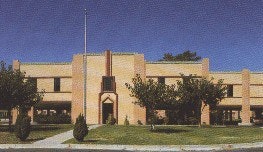 |
| The Navajo-run Albuquerque Service Unit consists of the 28-bed Albuquerque Indian Hospital and attached ambulatory care center, as well as healthcare centers at the Isleta, Jemez, and Alamo communities, and several field health clinics including Zia, Santa Ana, and Sandia. Photo courtesy of the Indian Health Service/U.S. Department of Health and Human Services. |
Each job listing describes its related relocation and family and housing benefits, Croft said. "There is usually some relocation assistance," he said. "Also, we generally do provide quarters for staff in our isolated hardship locations. If a person were to come to work at Fort Defiance (in the Navajo Nation), we would have staff quarters for them. However, if we assigned a person to the Phoenix Indian Medical Center, which is basically downtown Phoenix, AZ, we would expect the individuals to find their own housing."
Croft said that the IHS just opened a new facility in Fort Defiance, for which it has commenced a $10 million staff quarters project. "There are houses, multiplexes, quads, you name it. It depends on the individual’s housing needs. If they have a family, they’ll get probably a freestanding house. The rental rates are generally very reasonable. For example, at our Polacca, AZ, site, there is new housing that was built by the tribe, and it’s around $600 a month for a new three-bedroom home. And another perk to that is, if you’re a civil servant and you’re on call, you can write this off your taxes as a condition of employment."
What will new clinicians find on the job? The services offered by and modernity of IHS medical facilities vary widely. "We have the newest and the oldest (facilities)," said Croft. "We have a health center we just built in Parker, AZ, and that one is only about a year old. One of the oldest is in Yuma, AZ -- that one was built in 1932 and looks it."
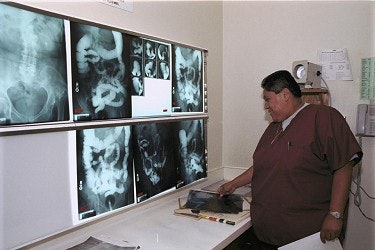 |
| The reading room at an IHS hospital in Albuquerque. Photo courtesy of the Indian Health Service/U.S. Department of Health and Human Services. |
But when it comes to high-tech healthcare, the IHS "actually led the nation in telemedicine and teleradiology in Arizona on the Tohono O’odham reservation," said Dr. Terrence Hamel, chief of diagnostic imaging at the Phoenix Indian Medical Center.
The newest facilities are filmless, and Gwilt said that many offer a full range of diagnostic examinations, including ultrasound and mammography. Approximately 10 sites have CT services, he said, and one site in Anchorage has an MR scanner. However, "we don’t get into interventional radiology, nuclear medicine, or therapy," he said.
Clinicians with the IHS perform both inpatient and outpatient examinations, Gwilt said, pointing out that the majority of IHS hospitals have fewer than 125 beds.
What’s a typical day like? It depends, IHS physicians said. "At a number of the facilities, the radiologists are not on call. They just work their regular day and we have images go on electronically to a university where the evening images are interpreted," Gwilt said. "Some facilities do have physicians that occasionally get called back or (who) may be consulted by phone, or possibly (they) look at images on their computer at home."
The challenge and the rewards
Providing healthcare to such a diverse population means IHS physicians see a variety of cases. "We see a smattering of things here, we pick up some cancers -- a few every week. There’s usually some inflammatory problems. A lot of diabetic-related processes. We’re very good at gallbladder disease here -- far better than anyone in the southwest. And (there’s) great (obstetric) care here," Hamel said.
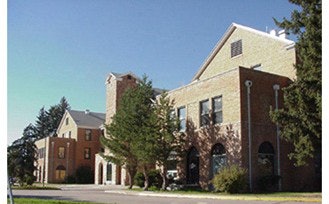 |
| The Sioux San Indian Hospital, Rapid City PublicHealth Service (PHS), in the Aberdeen area, serving North Dakota, South Dakota, Iowa, and Nebraska. Photo courtesy of the Indian Health Service/U.S. Department of Health and Human Services. |
Hamel pointed out that different centers encounter different trends in the cases they see. "For example, the tribes here don’t smoke much," he said, so his institution sees fewer smoking-related diseases.
In addition, Hamel said that "we have a tendency to see unusual things. For our size, we’ve submitted a significant number of cases to the (Armed Forces Institute of Pathology), where they’ve had trouble identifying what we’re sending them."
These cases, Hamel said, make his job even more challenging, and one of the things he likes best about working with IHS is the challenge rural medicine poses. "When you don’t have all the diagnostic tools and availability of resources out in the field, it makes you think a little bit harder about your training and your physical diagnosis skills and being a radiologist and trying to read a little bit more into that plain film that was done 300 miles away or at a place where they don’t have an ultrasound or a CT or anything like that."
But most important, Hamel said, is that he "enjoys the people and caring for their needs. That's why (I'm here)."
By Leslie FarnsworthAuntMinnie.com contributing writer
July 17, 2003
Related Reading
Digital telemammography trial underway at Navajo Nation, June 8, 2001
Copyright © 2003 AuntMinnie.com


















